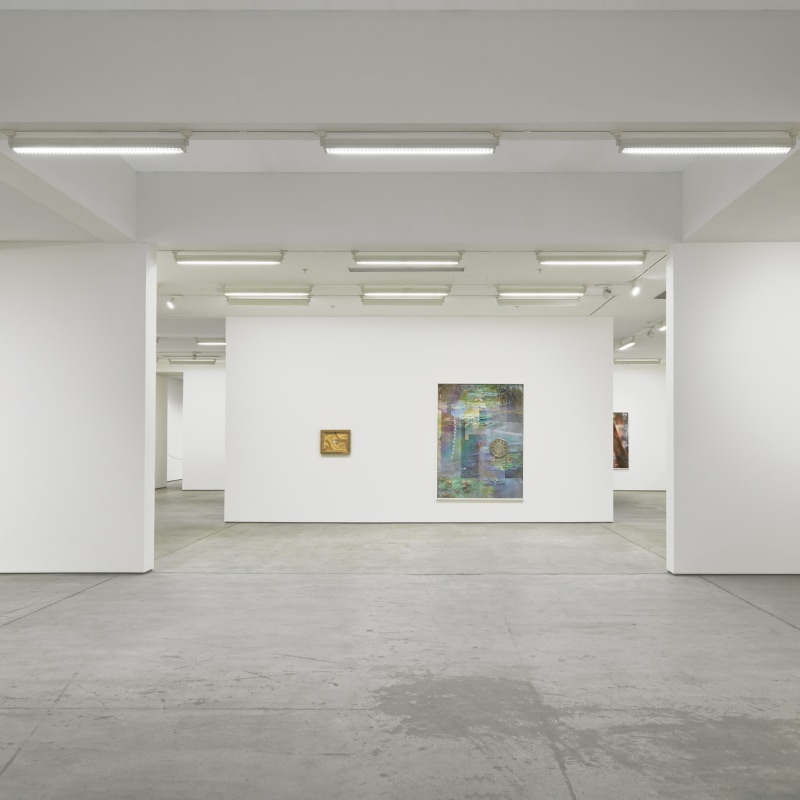In her second exhibition at Sadie Coles HQ, Michele Abeles presents four new series of works. Each uses photographic imagery to create a suspended, composite realm in which the artist plays out ideas of gender, power and psychology. Underlying Abeles’s latest works is the guiding idea of a waiting room – a locale of dilated time, open-ended potential and deferred knowledge. The waiting room constitutes a framework for Abeles’s recurring concerns at the same time as resonating with current political and social anxieties.
In a series of works conceived as bricolage, Abeles has created multipart constructions named after reptiles found in the swamps of Florida. She conceived of the modestly-sized works as hidden gems, of the kind seen that hang in the homes or offices of plutocrats. They have chunky ‘masculine’ frames, many of which are wrapped in imitation crocodile skin, or gilded with acrylic gold paint – a material gesture used both to mask and to upgrade. Paranoia runs rampant: each work contains not-so-hidden cameras and reflective materials such as fragments of broken mirror.
Two sets of work extend Abeles’s use of street photography with a focus on the male subject. For the first time, she includes her anonymous subjects’ faces in lieu of an abstracted body. The larger works are physically layered – backed with dye sublimation prints on aluminium (digital composites made from Abeles’s past works) and UV prints on Plexiglas (street photographs of mostly male subjects). Aluminium and Plexi adhere to one another via a layer of acrylic paint applied to the surface of the aluminium. The paint serves to redact the printed imagery both above and below, adding a durational dimension: with time, the acrylic may absorb more of the image.
Abeles’s photographic portraits of white male professionals on their way to work present oblivious white-collar subjects – sartorially codified and psychologically tuned-out (several are wearing wireless headphones), perhaps with the flicker of an existential crisis. These works were made with the intention of exploring what it means for a female artist to photograph, objectify and re-contextualize a male subject unawares, turning him into a vector of contemporary masculinity or machismo.
Abeles responds in a separate series to the kind of vacant imagery that populates waiting rooms. Digital reproductions of Monet’s Waterlillies are deployed as readymades: Abeles collates sections of the anodyne pictures together with elements from her own archive of works to produce hypnotic digital tapestries. The works’ tranquil palette, expansive scale and use of familiar imagery work together to seduce the viewer, perhaps inducing a palliative effect through the promise of visual and psychic escape. Yet their ostensible vacancy may equally lead the viewer back to where they started: facing reality, right here, right now.
Michele Abeles (b.1977, New York) has exhibited internationally with solo presentations including Zebra, 47 Canal, New York (2016); Baby Carriage on Bike or Riot Shield as Carriage, Whitney Museum of American Art, New York (2015); and Find Out What Happens When People Start Getting Real, Sadie Coles HQ, London (2014). Her work has featured in group exhibitions including Woman with a Camera, Museum of Contemporary Art, Chicago (2017); America Is Hard to See, Whitney Museum of American Art, New York (2015); DIDING – An Interior That Remains an Exterior?, Kunstlerhaus, Graz, Austria (2015); Second Chances, Aspen Art Museum, Aspen, Colorado (2015); A World of its Own: Photographic Practices in the Studio, MoMA, New York (2014); Speculations on Anonymous Materials, Fridericianum, Kassel, Germany (2013); Test Pattern, Whitney Museum of Art, New York (2013); 12th Biennale de Lyon, France (2013); Empire State, curated by Norman Rosenthal and Alex Gartenfeld, Palazzo delle Esposizioni, Rome (2013); and New Photography 2012, Museum of Modern Art, New York (2012). Milano v2, her public commission for Tate Modern, is currently on view in London until spring 2020.
